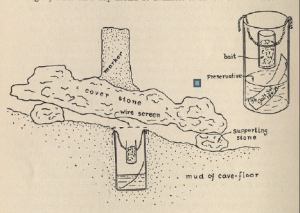In 1970 an entomologist working on the black bean aphid, Aphis fabae, at Rothamsted Experimental Station (as it then was), noted that he could categorise the winged individuals as either migrants, flyers or non-flyers; the former flying before they reproduced, the second flying after they reproduced and the final category, never flying (Shaw, 1970). To describe this phenomenon he used the phrase “migratory urge” a term previously only used in the ornithological literature.
A few years later a group of PhD students in Tony Dixon’s lab at the University of East Anglia started dissecting aphids and counting their ovarioles, finding that unlike most other insects, ovariole number was variable within a species and not related to adult weight (Dixon & Dharma, 1980; Wellings et al., 1980; Leather, 1983). Generally speaking, in insects, including aphids, the heavier they are, the more fecund they are, although in some instances this is not always true (Leather, 1988).
Figure 1 taken from http://www.aphidsonworldsplants.info/Cloning_Experts_3.htm
Figure 2 What aphid ovarioles really look like Dombrovsky et al. BMC Research Notes 2009 2:185 doi:10.1186/1756-0500-2-185
What we found then (Wellings et al., 1980), and later (Leather et al., 1988), was that aphids with wings (alatae) even those from the same clone, had much more variability in the number of ovarioles contained within them than those without wings (apterae) (Leather et al., 1988), and that the more ovarioles an aphid contained the more fecund it was, although as mentioned earlier the number of ovarioles appeared to be independent of weight (Leather & Wellings, 1981).
So what does this have to do with migratory urge in Aphis fabae? In the early 1980s Keith Walters was working on migration in cereal aphids (Sitobion avenae and Rhopalosiphum padi) and discovered, that as with Aphis fabae these two species also produced alatae with different flight attributes (Walters & Dixon, 1983). Building on what we in our group had discovered about ovarioles, Keith was able to show that the degree of migratory urge in aphids was determined by the number of ovarioles they contained. The greater the number of ovarioles the more reluctant they were to take flight (Figure 3ab).
Figure 3a Relationship between number of ovarioles and time to take-off (minutes) in Sitobion avenae (Drawn from data in Walters & Dixon, 1983).
Figure 3b Relationship between number of ovarioles and time to take-off (minutes) in Rhopaloisphum padi (Drawn from data in Walters & Dixon, 1983).
He also found that the fewer the number of ovarioles, the steeper the angle of take-off was (Figure 4) i.e. aphids with few ovarioles climbed faster and more steeply and were thus more likely to end up higher in the air, and thus more likely to travel further than those
Figure 4 Relationship between number of ovarioles and angle of take-off (degrees) in Rhopalosiphum padi (drawn from data in Walters & Dixon, 1983).
taking off at a shallower angle. He also showed that resistance to starvation was greater in those aphids with fewer ovarioles and that they could also fly for longer periods of time. Given that alatae of Aphis fabae also have a variable number of ovarioles, 6-12 (Leather et al., 1988), we can see that this fits in very well with Shaw’s classification of migrants, flyers and non-flyers.
This is yet another great example of the flexibility (plasticity) of the aphid clone. By producing offspring that have different flight capabilities and propensities, the clone is able to hedge its bets in times of adversity; alate aphids in many aphid species are produced in response to crowding and/or poor nutritional quality (Dixon, 1973). This deterioration in living conditions could be very local i.e. restricted to the plant on which the aphid is feeding or its immediate neighbours, slightly more widespread, i.e. at a field scale or at a much more widespread landscape scale. Given that long distance aphid migration is very costly (only a tiny proportion survive, Ward et al, 1998) the best option is to spread the risk between the members of your clone. Those individuals with more ovarioles and greater potential fecundity make the low risk short-distance hops (trivial flights), but take the chance that the next door plant might be just as bad as the one left behind and also within easy reach of natural enemies, but with a higher chance of arriving and reproducing.
A risk taking aphid!
At the other end of the scale, those clone members with fewer ovarioles and reduced potential fecundity make the long distance migratory flights, with the risk of not finding a suitable host plant in time, but with the chance that if they do, it will be highly nutritious and natural enemy-free. A really good example of not putting all your eggs in one basket and yet again a demonstration of what fantastic insects aphids are 😉
References
Dixon, A.F.G. (1973) Biology of Aphids Edward Arnold, London.
Dixon, A.F.G. & Dharma, T.R. (1980) Number of ovarioles and fecundity in the black bean aphid, Aphis fabae. Entomologia Experimentalis et Applicata, 28, 1-14.
Leather, S.R. (1983) Evidence of ovulation after adult moult in the bird cherry-oat aphid, Rhopalosiphum padi. Entomologia experimentalis et applicata, 33, 348-349.
Leather, S. R. (1988). Size, reproductive potential and fecundity in insects: Things aren’t as simple as they seem. Oikos 51: 386-389.
Leather, S.R. & Welllings, P.W. (1981) Ovariole number and fecundity in aphids. Entomologia experimentalis et applicata, 30, 128-133.
Leather, S.R., Wellings, P.W., & Walters, K.F.A. (1988) Variation in ovariole number within the Aphidoidea. Journal of Natural History, 22, 381-393.
Shaw, M.J.P. (1970) Effects of population density on the alienicolae of Aphis fabae Scop.II The effects of crowding on the expression of migratory urge among alatae in the laboratory. Annals of Applied Biology, 65, 197-203.
Walters, K.F.A. & Dixon, A.F.G. (1983) Migratory urge and reproductive investment in aphids: variation within clones. Oecologia, 58, 70-75.
Ward, S.A., Leather, S.R., Pickup, J., & Harrington, R. (1998) Mortality during dispersal and the cost of host-specificity in parasites: how many aphids find hosts? Journal of Animal Ecology, 67, 763-773.
Wellings, P.W., Leather , S.R., & Dixon, A.F.G. (1980) Seasonal variation in reproductive potential: a programmed feature of aphid life cycles. Journal of Animal Ecology, 49, 975-985.















































